Sunlight filters into a dining room like an uninvited guest—sometimes a welcome burst of warmth, other times a glare that steals the mood from a shared meal. Choosing the right dining room window treatments is about more than decorating; it’s about creating a gathering place where conversation, color, and comfort meet. Deciding among fabric, shade, or shutter might feel overwhelming, yet each option can balance privacy, light control, and style when matched with the room’s architecture and daily rhythm. Ready to discover approaches that elevate your next dinner and simplify maintenance? Explore these inspiring ideas and see which solution suits your table best.
1. Floor-Length Drapery Window Treatment Elegance
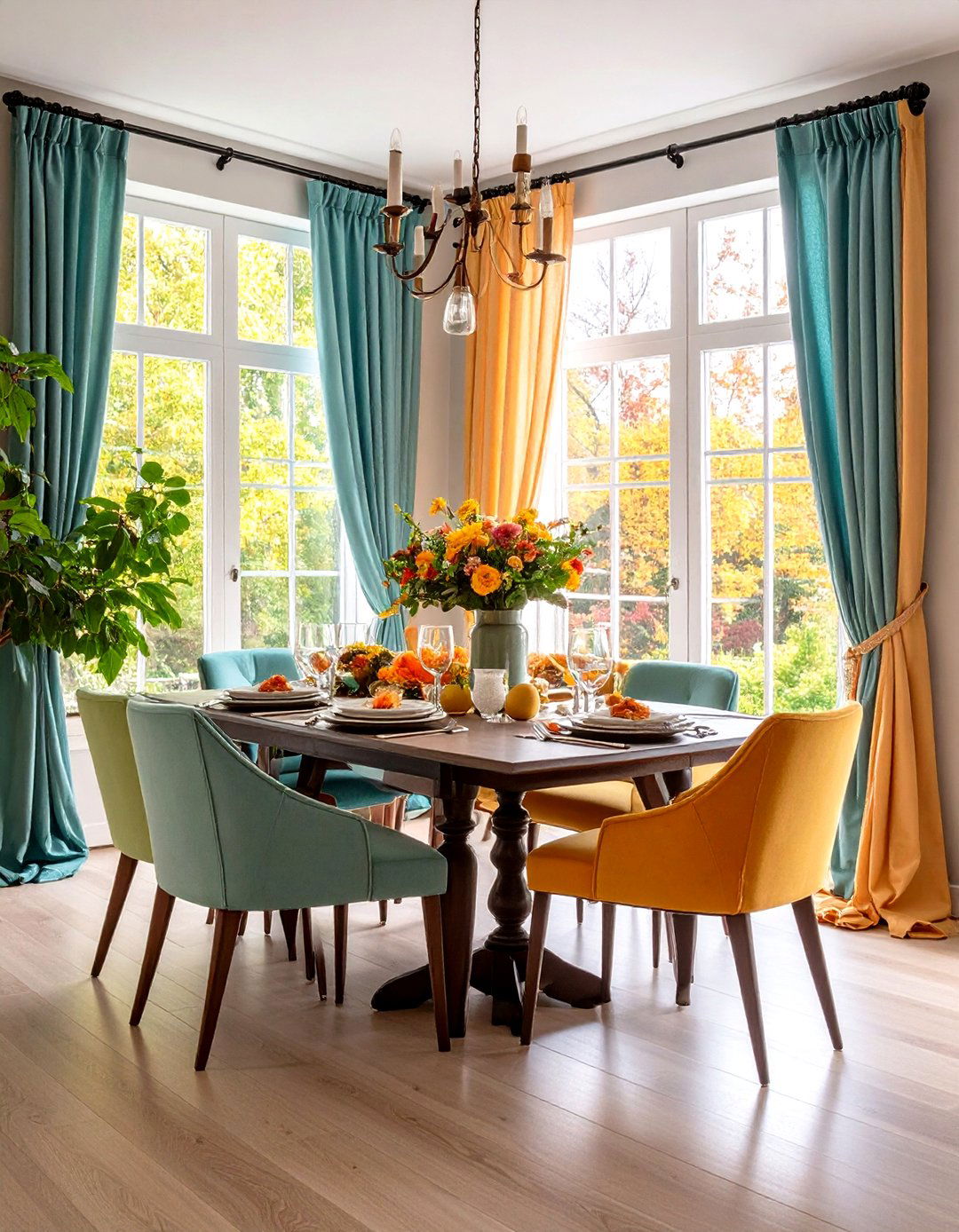
A well-tailored set of floor-length, lined drapes instantly anchors any dining room window treatment with timeless poise. The puddle of fabric brushing the floor creates a sense of occasion, while the built-in lining blocks harsh afternoon sun that could fade heirloom furniture. Opt for pinch-pleat or ripple-fold headers so panels stack neatly without hogging valuable wall space. Insider tip: mount the rod at least six inches above the trim and extend it eight inches past each side; this visual trick makes the window feel grander and lets more light spill in when curtains are open. Finish with weighty metal rings for fluid movement.
2. Sheer Linen Window Panels for Soft Daylight
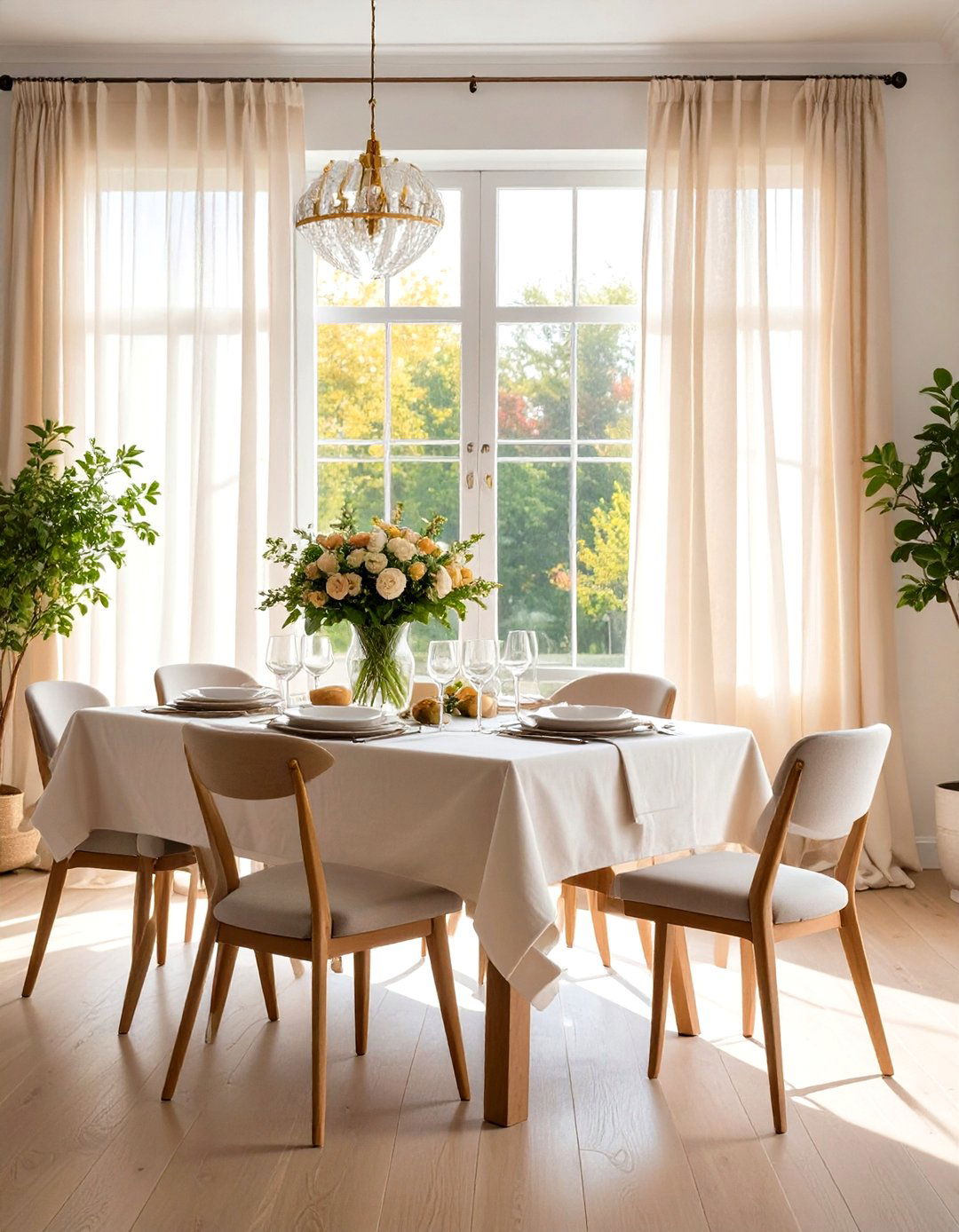
Flickering candlelight at dinner looks even lovelier when diffused through sheer linen dining room window treatments. Lightweight, loosely woven fabric softens glare without sacrificing the open, airy feeling that keeps guests relaxed. Choose off-white or natural flax hues to complement most wood finishes, and hem panels to just kiss the sill for a crisp, unfussy line. To prevent billowing in summertime drafts, hand-stitch discreet penny weights into the bottom corners; the extra heft keeps cloth from flapping against glassware. Pair sheers with discreet roller shades hidden inside the frame, giving you instant privacy for late-night snacks without cluttering the serene daytime look.
3. Tailored Roman Window Shades with Graphic Prints
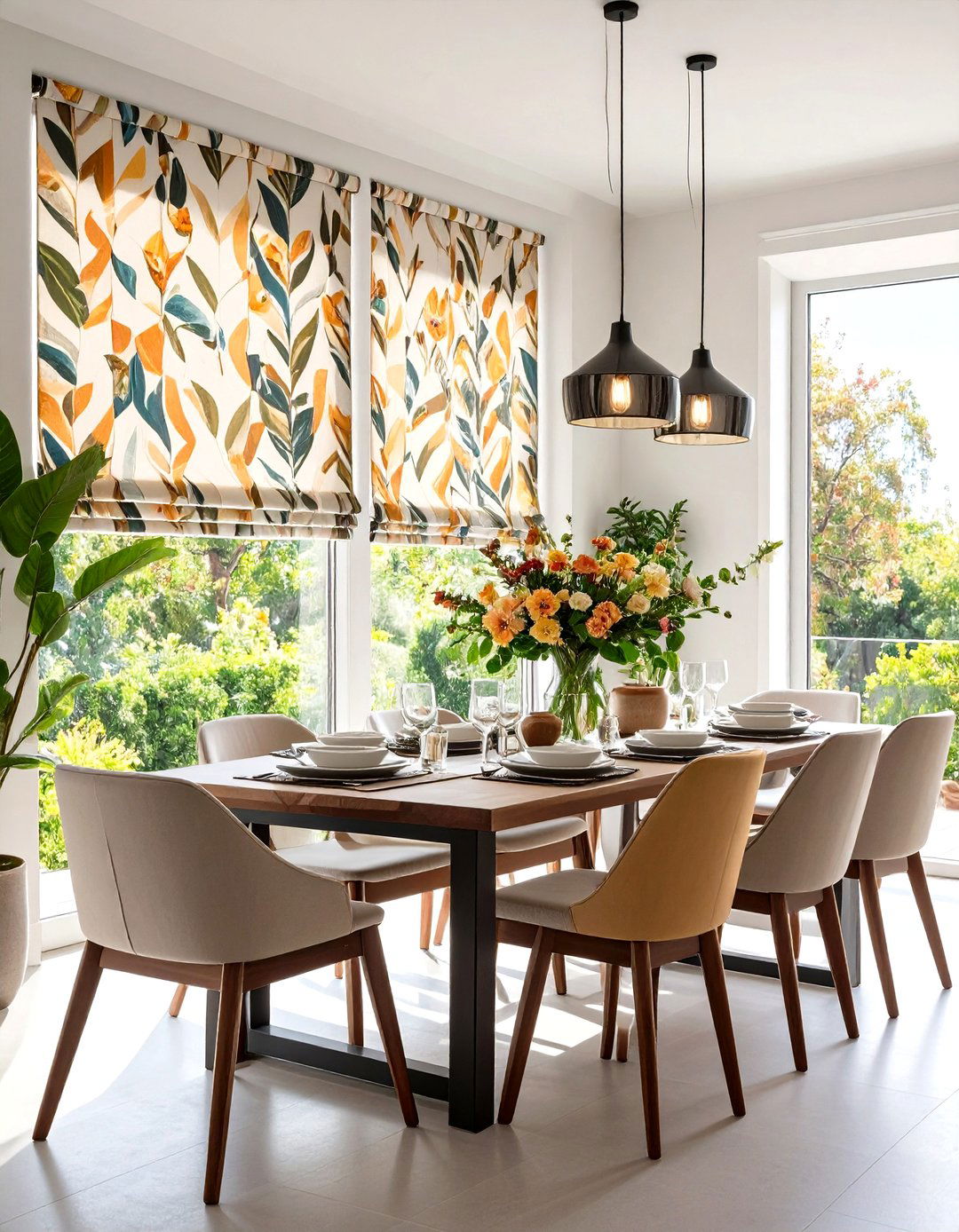
Nothing enlivens a neutral dining set faster than a tailored Roman shade splashed with a bold, graphic pattern—a window treatment that doubles as art. The crisp folds tuck neatly away when raised, revealing trim details or beautiful outdoor greenery, yet lie flat and streamlined when lowered, perfect for rooms that need minimal bulk. Select performance cotton or a linen-blend so the shade holds its shape through daily tugging. For perfect symmetry, order custom lengths that stop just above the sill. A continuous clutch mechanism feels smoother and safer than a dangling cord, and you can easily swap fabric later if you refresh the palette.
4. Woven Wood Window Shades Bring Organic Warmth
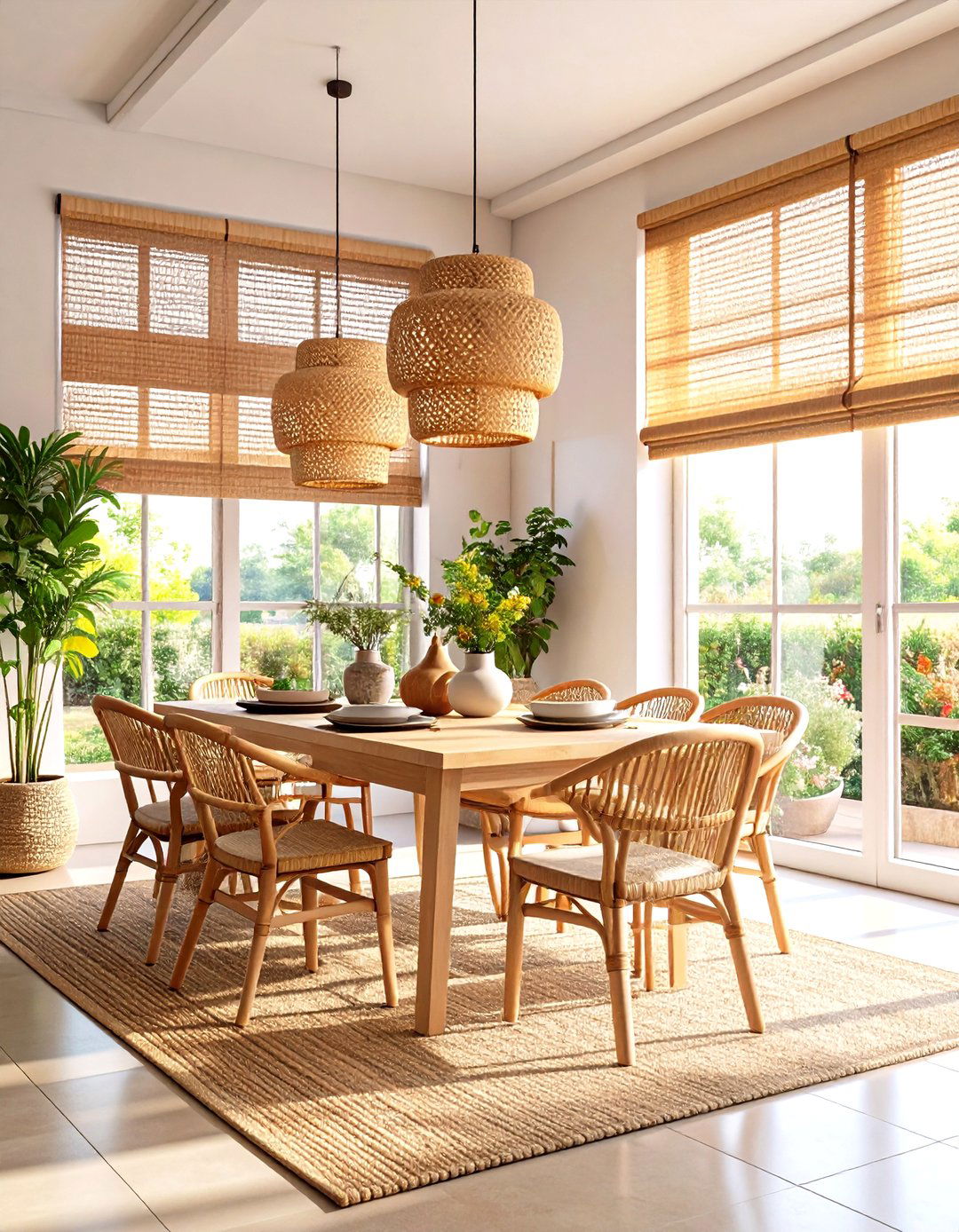
By day, woven wood dining room window treatments sweep sunlight through natural slats, casting gentle latticed shadows that make soup and salad feel like a picnic indoors. Made from bamboo, grasses, or reeds, these shades add instant texture and warm undertones that complement oak floors or rattan chairs. Ask for an optional light-filtering liner to reduce glare without losing the earthy vibe. Mounting hardware can sit inside the frame for a clean architectural line, but outside mounts hide uneven moulding beautifully. Remember to order edge banding in a contrasting color to prevent fraying, and consider a top-down bottom-up lift for precise privacy control.
5. Layered Window Sheers and Drapes for Versatility
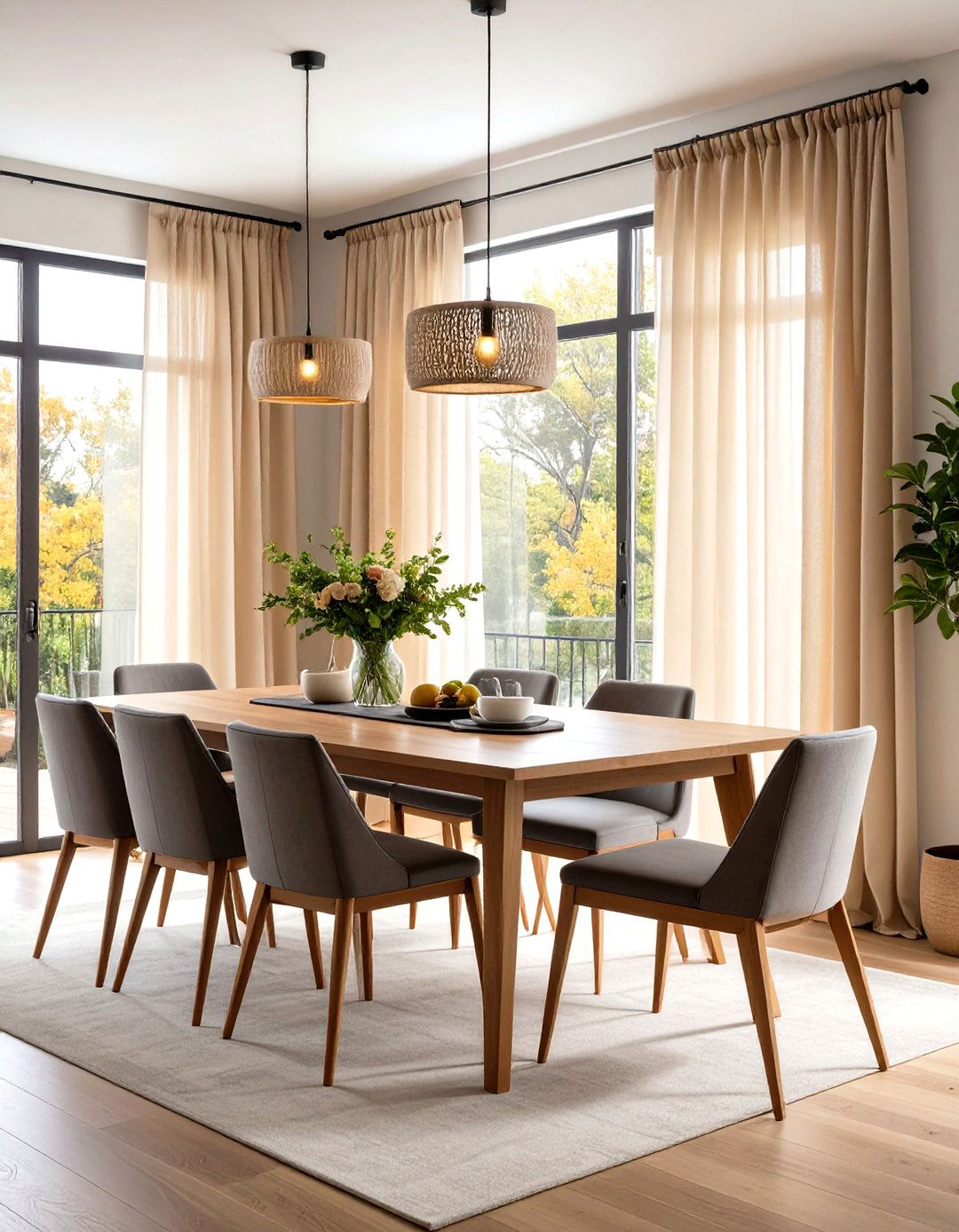
Consider the tried-and-true hotel approach: pairing translucent sheers with heavier drapery gives a dining room window treatment chameleon-like flexibility. Morning brunch needs diffused daylight? Leave the sheers drawn and sweep the drapes aside. Evening fondue requires intimacy? Close everything and enjoy plush acoustic softness. To keep layers from feeling bulky, choose a slim double rod or a track system that hides under a sleek cornice. Let colors converse—perhaps ivory sheers beneath slate blue velvet for a balanced palette. Always hem both fabrics to identical lengths, preventing a messy staggered edge that distracts from table décor. Quick vacuuming with a brush attachment keeps lint at bay.
6. Casual Café Window Curtains for Cozy Charm
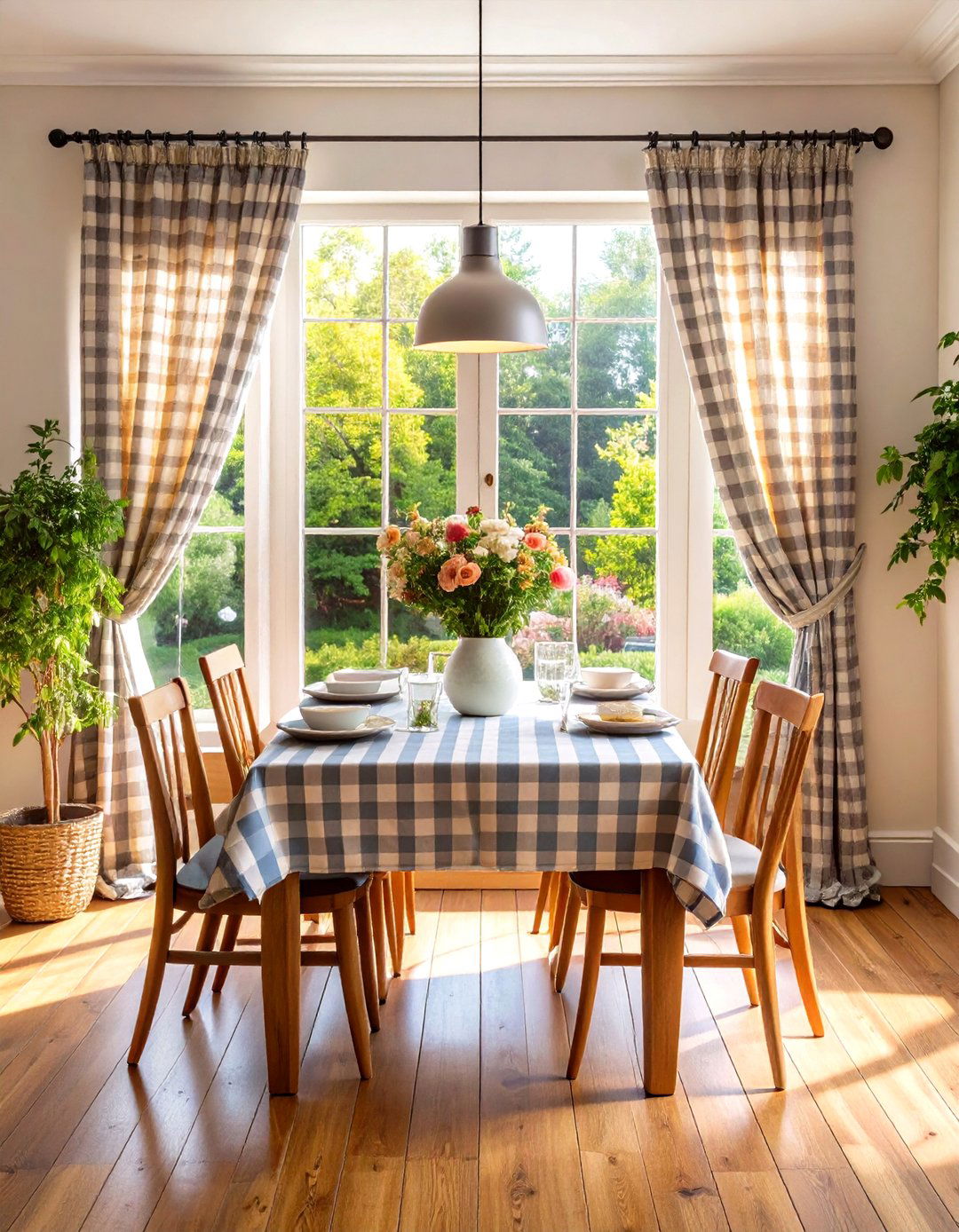
Shortly cutting across only the lower half of the glass, café-style dining room window treatments cultivate a café-like intimacy without blocking sky views. This split-level approach lets fresh air stream through the top sash while fabric shields diners from street-level sightlines. Lightweight ticking stripe or gingham cotton evokes nostalgic French bistros, but any small-scale print will work as long as it coordinates with dishware. Mount the rod at mid-pane height or on the sash for easy removal come wash day. For extra polish, add a matching fabric valance up top to hide hardware and echo the pattern, unifying the relaxed aesthetic.
7. Luxe Velvet Window Drapery for Formal Gatherings
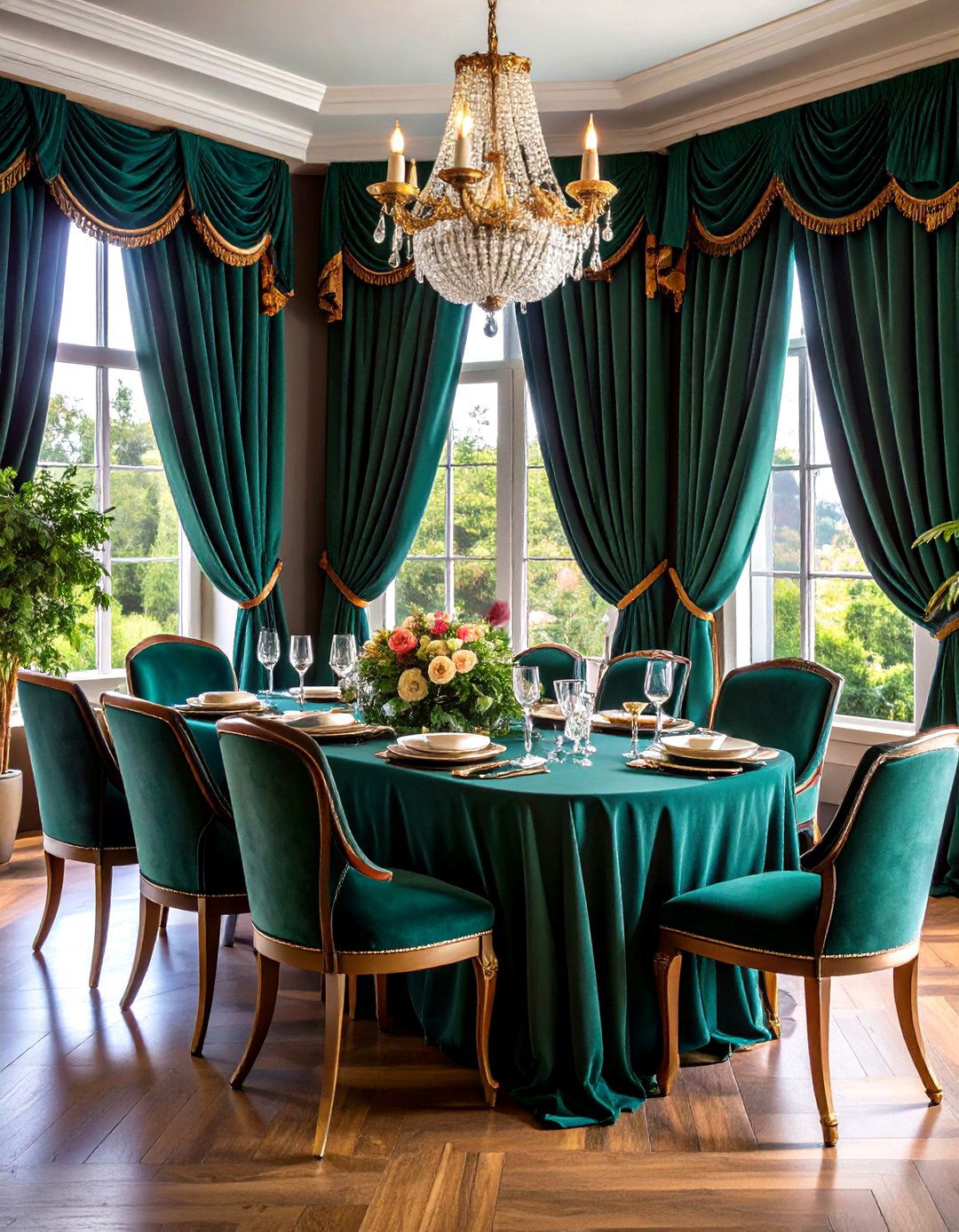
The moment lush velvet ripples down a wall, guests sit up a little straighter—this dining room window treatment sets a refined, almost theatrical tone. Dense pile fabric excels at muffling clatter from clinking plates and delivers excellent insulation on chilly evenings. Jewel tones like emerald or merlot accent mahogany tables beautifully, but smoked charcoal velvet can modernize light oak furniture. Because velvet is weighty, invest in a sturdy steel rod with decorative finials, and space brackets every three feet to prevent sagging. Steam panels from the back to lift crush marks, and draw them at twilight to amplify candle sconces for a captivating glow.
8. Cellular Window Shades Cut Energy Bills
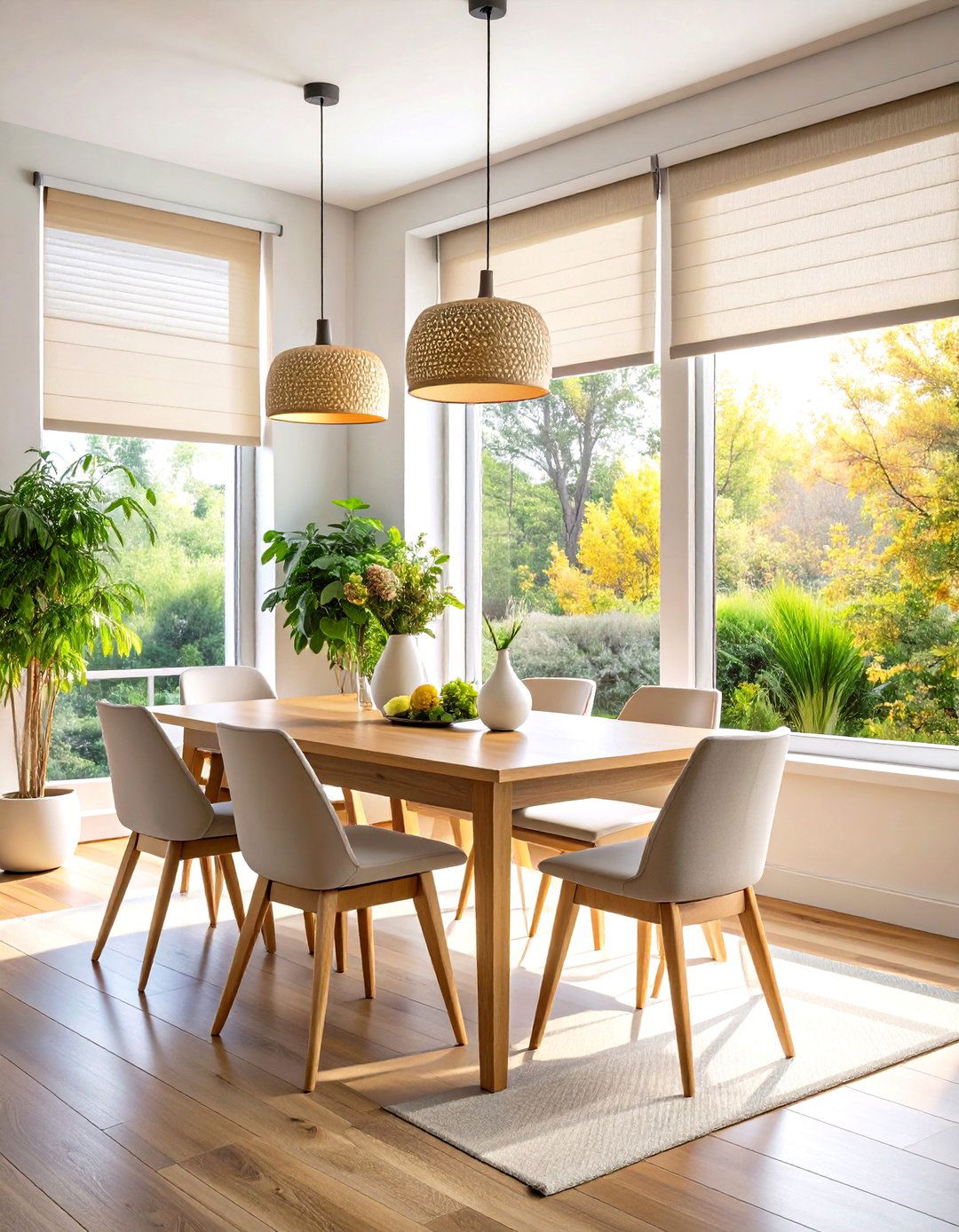
Unlike many decorative options, honeycomb cellular shades tackle a practical pain point—temperature swings—while still presenting a sleek dining room window treatment. The shade’s layered air pockets trap heat in winter and block scorching summer rays, contributing to noticeable utility savings. Opt for light-filtering fabrics so daylight still washes the room in a gentle glow, or choose blackout material if movie nights happen at the table. Cordless lifts keep spaces child-safe and streamline the profile. For tall windows, consider motorization that pairs with voice assistants, letting you adjust ambiance without leaving your seat between courses. Regular dusting with a hairdryer on cool maintains freshness.
9. Tailored Window Valances Frame the View
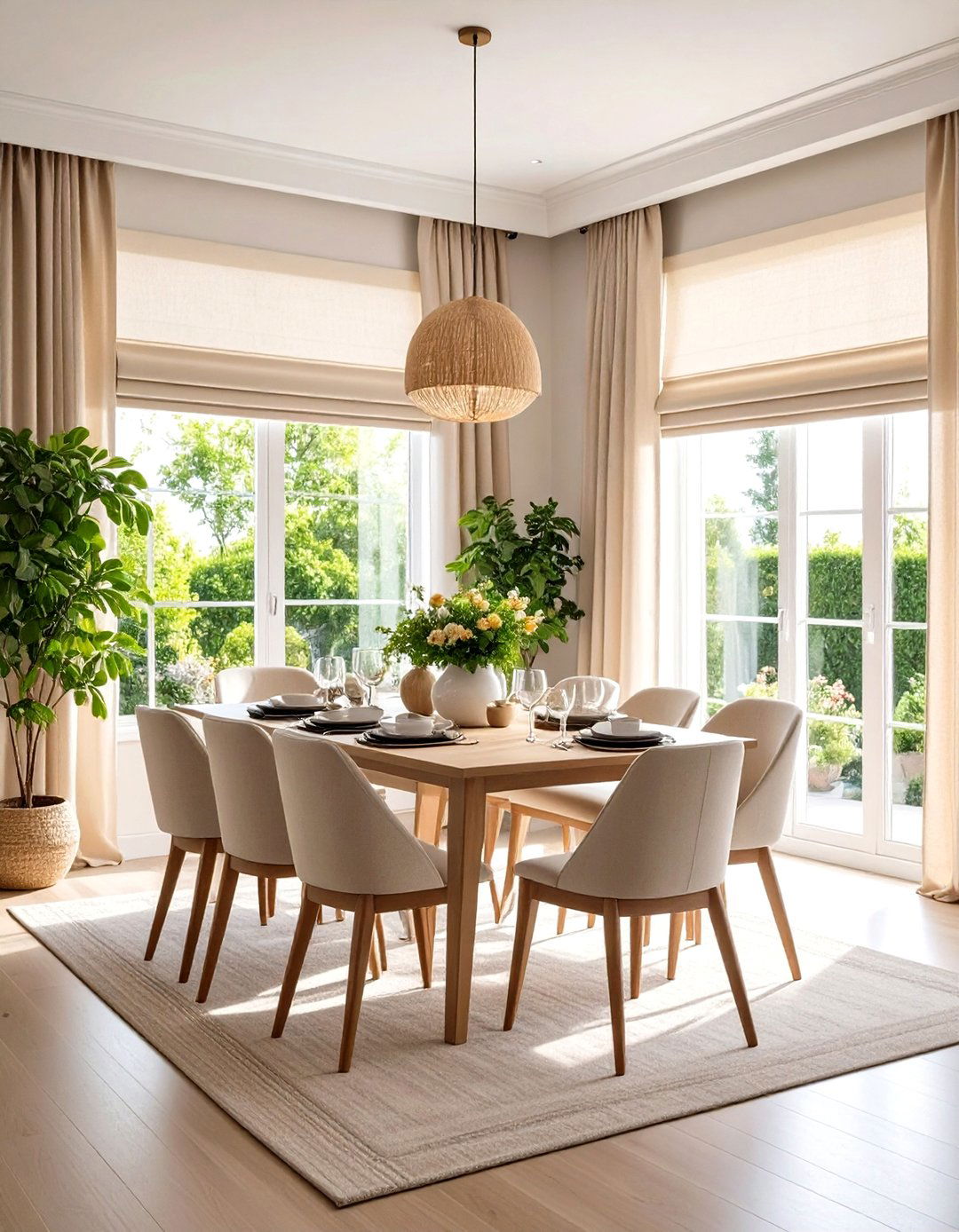
A crisp, tailored valance can be the jewelry of a dining room window treatment, skimming the top edge like a structured crown. Because it covers hardware but not glass, the valance draws eyes upward, elongating low ceilings without sacrificing sunlight. Choose board-mounted styles for the sharpest corners, and pad with interlining so fabric drapes firmly. Subtle banding or welt cord introduces a hint of color that ties to the table runner beneath. To avoid a heavy pelmet look, limit the drop to one-sixth the window height. Every few seasons, steam the valance in place rather than removing it, preserving flawless angles.
10. Plantation Window Shutters Offer Structured Serenity

Solid wood plantation shutters lend structured rhythm to a dining room window treatment and can outlast many fabric alternatives. Adjustable louvers let you fine-tune daylight and breeze—angling blades slightly upward blocks direct glare while still bouncing light toward the ceiling. Paint shutters to match trim for a seamless architectural statement, or stain them a deep espresso for contrast against light walls. Because shutters create bulk when open, order bifold panels on larger windows so they stack compactly to the sides. Wipe slats weekly with a microfiber cloth followed by orange-oil polish; the subtle citrus scent doubles as a welcoming pre-dinner aroma.
11. Motorized Window Roller Shades Blend Technology and Style
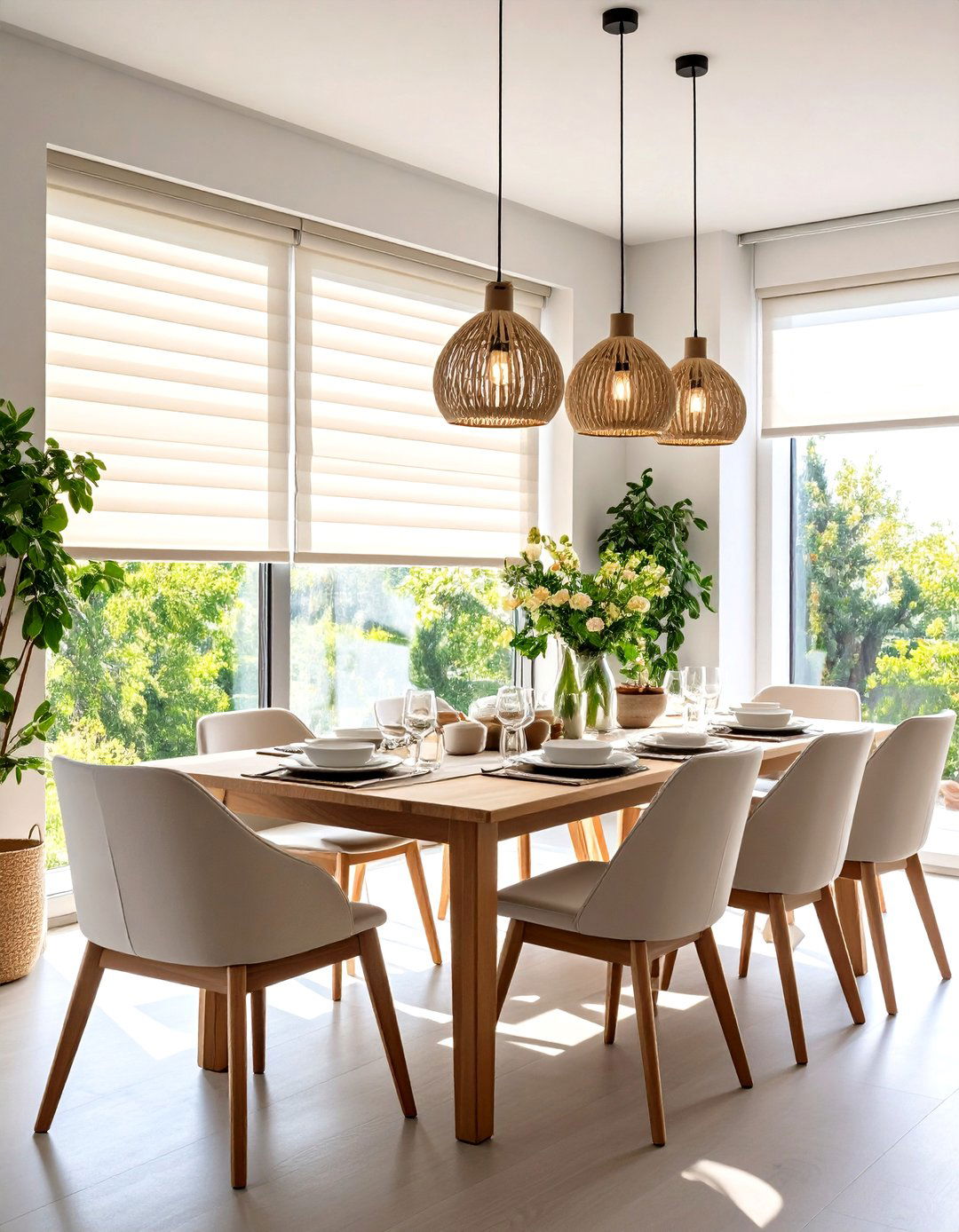
As research into smart homes grows, motorized roller shades have become a go-to dining room window treatment for tech-savvy hosts. The minimalist fabric roll virtually disappears into a slim cassette when raised, preserving full views for daytime gatherings. Schedule the shades to lower fifteen minutes before sunset, preventing glare on glassware without any manual effort. Look for quiet DC motors and rechargeable batteries that hide inside the tube, eliminating the need for hard-wiring during retrofits. Many systems integrate with voice assistants or smartphone scenes—dim the chandelier and drop the shades simultaneously for instant ambiance. Remember to select UV-blocking fabric to protect treasured textiles.
12. Stained Glass Window Inserts Craft a Statement

Owing to their kaleidoscopic sheen, stained glass inserts turn the simplest sash into a dining room window treatment that feels like fine art. Instead of hanging fabric, leaded panels are fitted directly into small sections of the existing frame or installed as removable storm windows. Every sunset then paints colored patterns across china and linens, saving you from extra décor on the walls. Keep the design modern with geometric motifs and subtle neutrals, or lean traditional with floral jewelled panes. Because stained glass limits outward visibility, pair inserts with operable transoms or clerestory windows to maintain ventilation. Dust gently with a natural-hair brush to preserve the lead cames.
13. Bamboo Window Blinds with Drapery Accents

Bringing together tactile bamboo blinds and soft side panels offers a dining room window treatment that balances raw nature with refined texture. The blind’s thin slats filter sunlight in warm, golden stripes, while flanking drapes introduce color and plushness. Choose unlined bamboo for rooms needing brightness, then add blackout-lined curtains to achieve nighttime privacy without replacing the core shade. Tie-back holders keep fabric from blocking airflow during steamy summers. Match the drapery trim to the cane’s honey undertones for cohesion. Once a month, vacuum the blind using a brush attachment, and spot-clean spills on fabric promptly to maintain the duo’s crisp contrast.
14. Metallic Thread Window Curtains for Understated Glamour
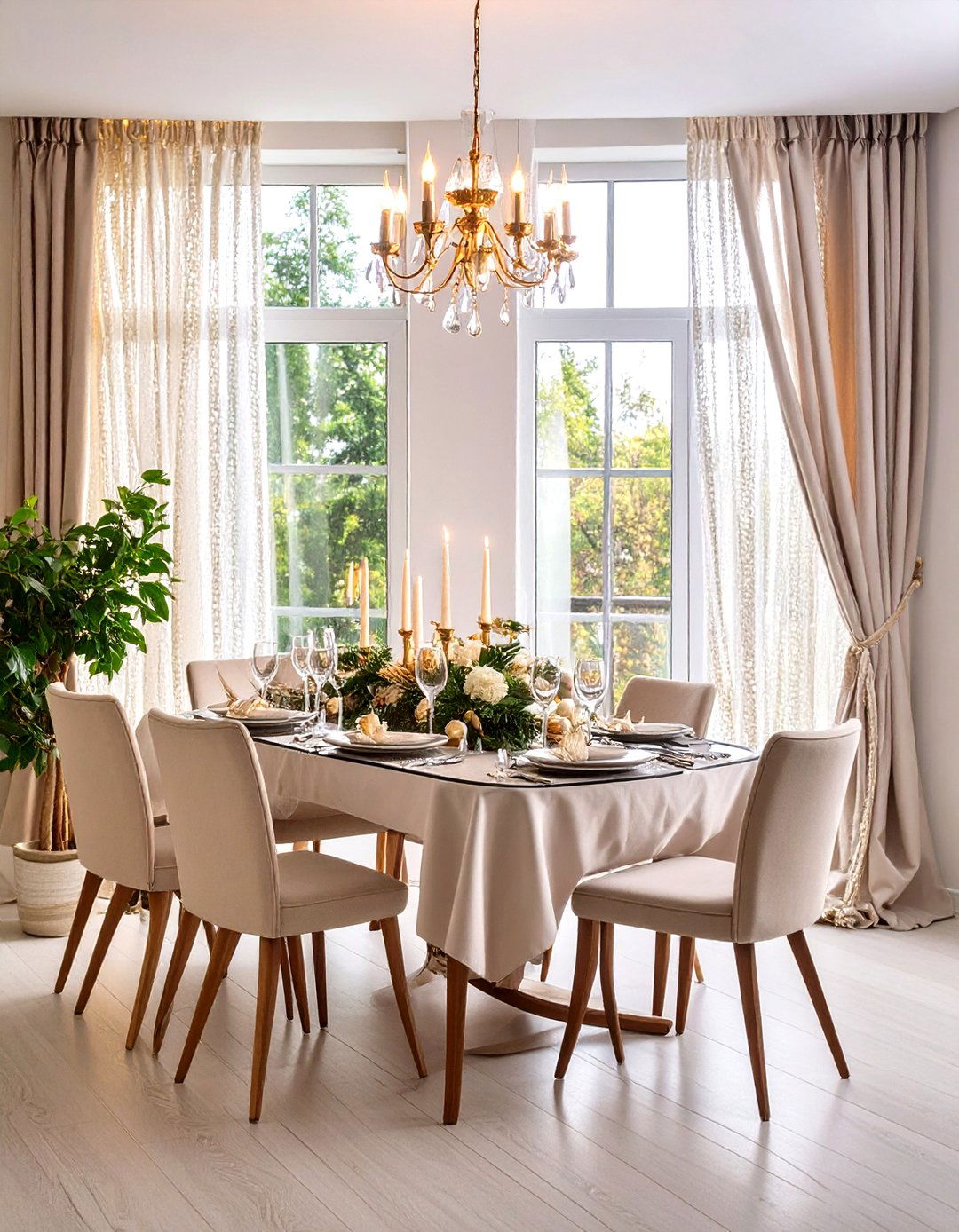
Surprisingly, just a kiss of metallic thread can transform plain fabric into a dining room window treatment shimmering with understated glamour. Lightweight polyester-linen blends woven with silver or champagne filaments catch candlelight and holiday twinkle lights without veering into gaudy territory. Stick to muted solids so the sparkle feels like morning frost rather than festival tinsel. Install hidden tab-tops to keep the header clean; exposed grommets might compete with the fabric’s subtle shine. When laundering, use a mesh bag and gentle cycle to prevent snagging delicate fibers. Iron on low heat from the lining side, preserving the threads’ reflective finish.
15. Corner Window Bench with Integrated Curtains
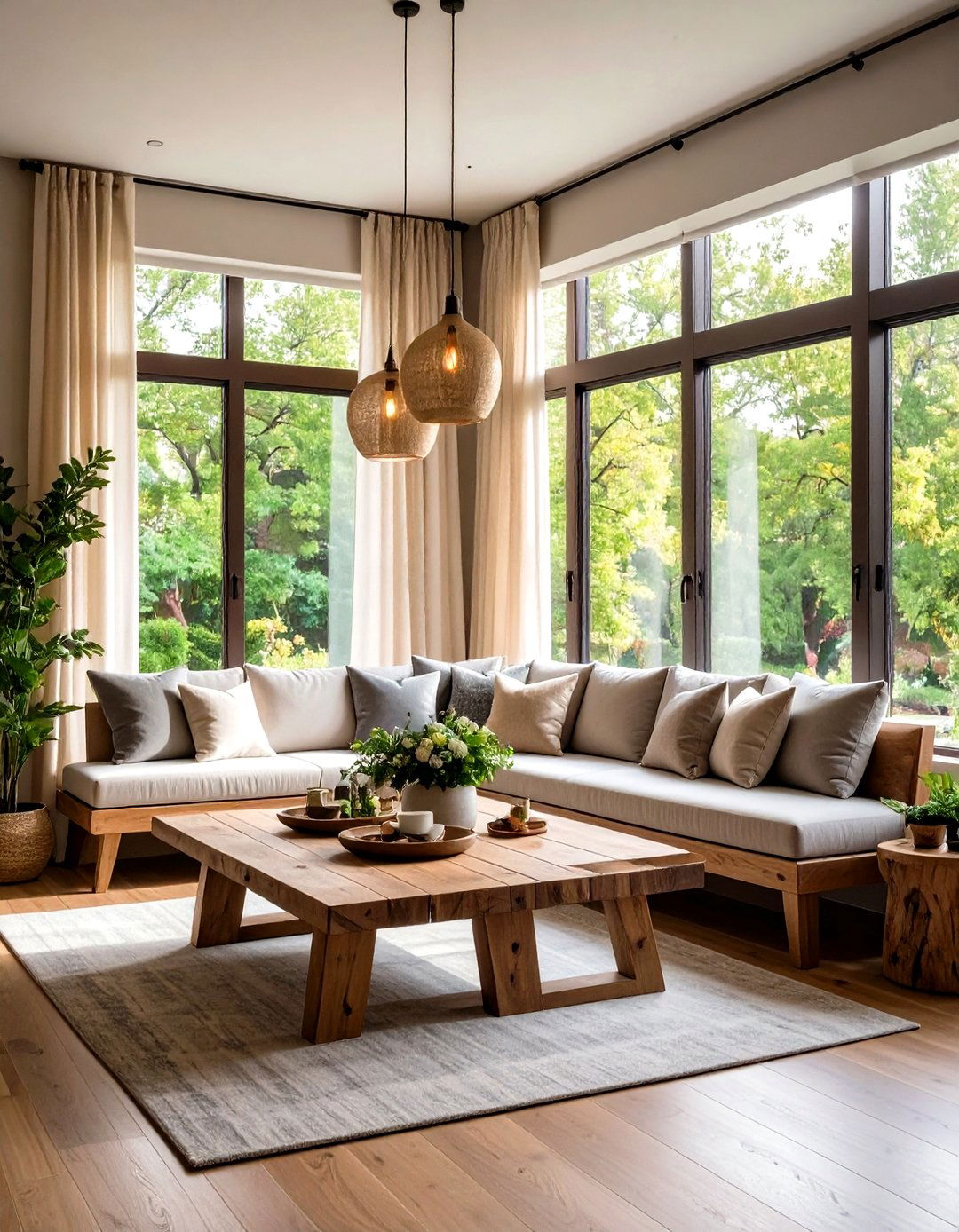
Take advantage of awkward corner windows by designing a built-in bench wrapped in an L-shaped dining room window treatment. Seat cushions invite leisurely brunches, while ceiling-mounted track curtains slide smoothly around the angle, cocooning diners on breezy evenings. Choose washable performance velvet for seat upholstery and coordinate curtain fabric in a lighter tone to prevent visual heaviness. To avoid tangled slides, install a curved corner connector that lets gliders turn without snagging. Beneath the bench, hidden drawers store linen napkins and seasonal chair cushions, making the nook multifunctional. Finish the frame with sconce lighting so curtains glow softly when drawn.
16. Ceiling-Mounted Window Track Drapes Elevate Height
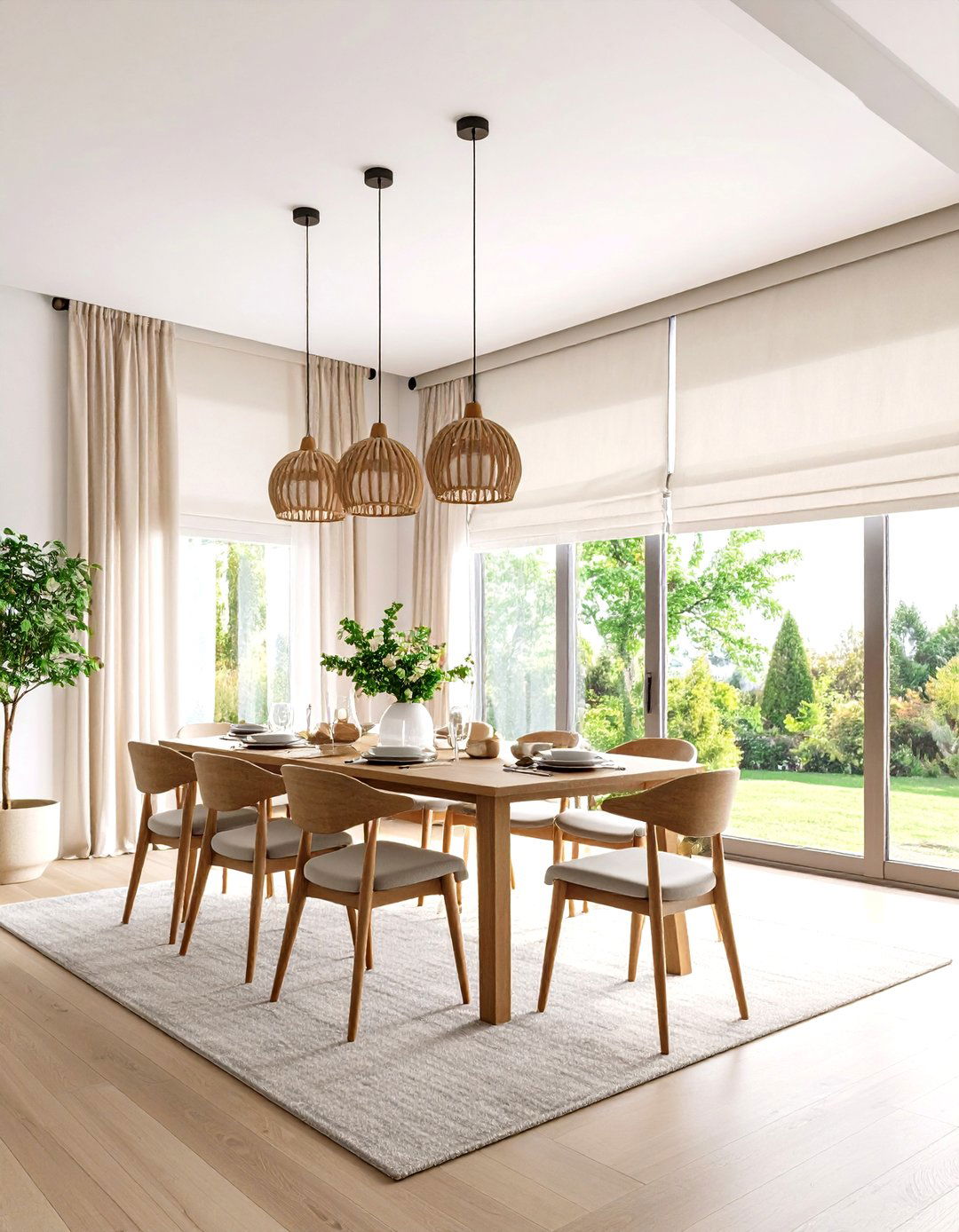
With a few screws in plaster, ceiling-mounted track drapes make any dining room window treatment soar, visually extending walls upward like a haute couture runway. By suspending fabric from the highest point available, you hide uneven trim and create uninterrupted vertical lines that complement tall candle holders and elongated centerpieces. Tracks also allow effortless one-finger glides across wide expanses, perfect when serving courses. Choose lightweight crepe for graceful puddles without excessive weight on the anchors. Paint the track to match ceiling color, letting the hardware disappear. If your space has coves or bulkheads, cut the track into segments that follow the architecture’s curve seamlessly.
17. Color-Blocked Window Panels Add Modern Edge

Certainly, dynamic color-blocked drapery gives a modern jolt to a traditional dining room window treatment. Think two-thirds oyster white topped by one-third deep navy band, or a playful trio of desert neutrals. The horizontal break subtly widens narrow windows, while a vertical block elongates squat frames—pick whichever balances the room’s proportions. Sew blocks with mitered seams and hidden stitching so the transition appears crisp and tailored. Keep hardware minimal; a matte black rod and cylinder finials echo the graphic style. If you worry about trend fatigue, choose detachable bottom bands secured with invisible zippers, letting you swap shades seasonally without replacing the entire panel.
18. Embroidered Window Sheers Introduce Delicate Pattern
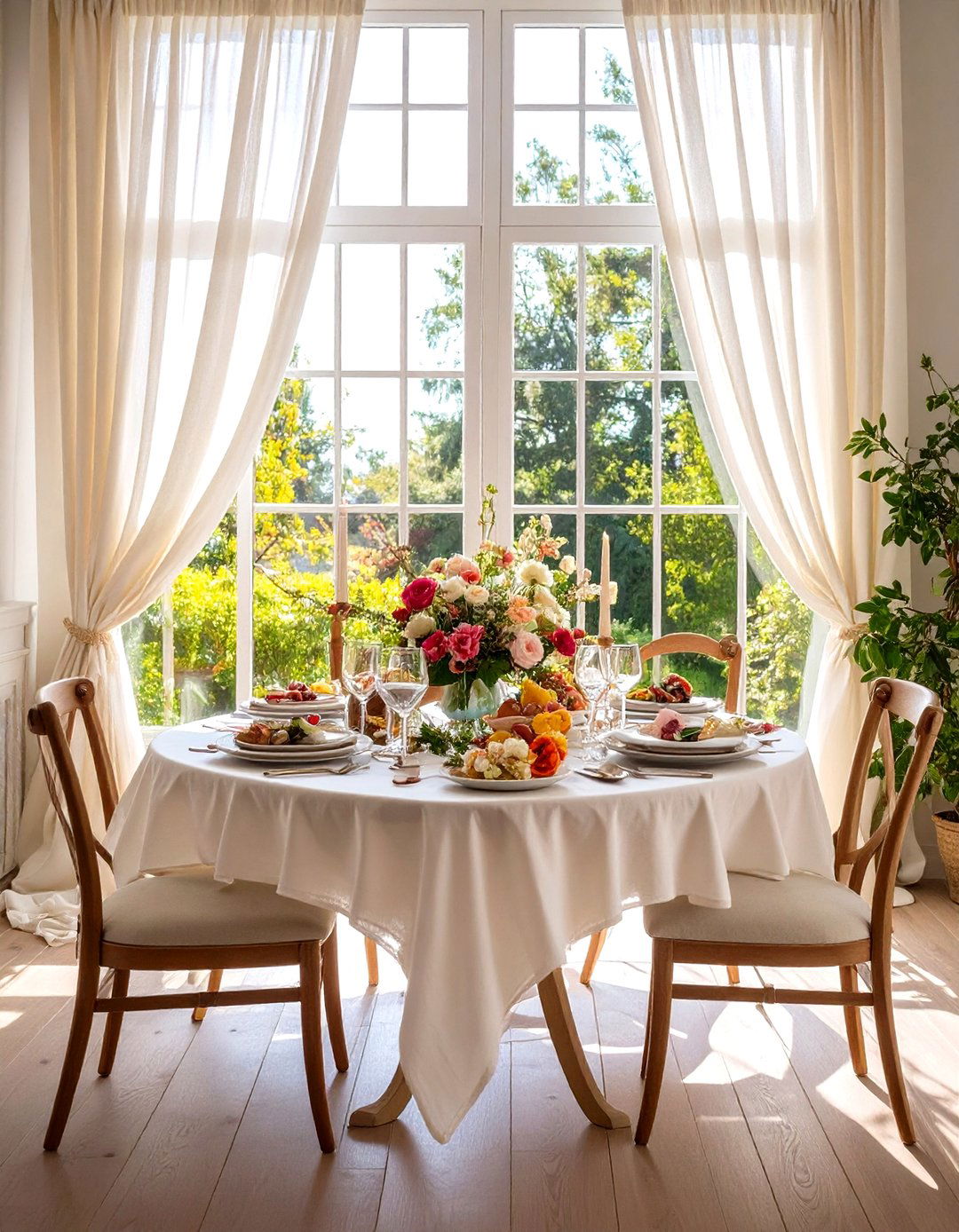
Looking for texture without heaviness? Embroidered sheers weave subtle pattern into a dining room window treatment while preserving an ethereal glow. Choose botanical vine stitches for cottage charm or geometric lines for urban lofts; either option plays nicely with mixed table linens. To showcase the needlework, mount rods several inches beyond the frame so panels clear glass fully when opened. Because embroidery can pull on lightweight fabric, specify cotton-poly threads and request extra interlock reinforcement at high-stress pleats. Hand-wash in cool water and hang damp to avoid shrinkage. The resulting play of stitched motifs and shifting daylight makes every meal visually intriguing.
19. Smart Window Tint Film Delivers Futuristic Control

For gadget lovers, electrochromic smart film turns glass itself into an adaptable dining room window treatment, frosting over at the tap of a phone. The self-adhesive sheet sticks to existing panes, drawing minimal power to switch from transparent to opaque in under a second—ideal for surprise dinner parties or projector game nights. Unlike blinds, film has no moving parts to dust and frees sill space for herb planters. Install with a certified low-voltage transformer, hiding wiring behind moulding for a seamless look; most kits plug into standard outlets. If local codes allow, couple the film with solar panels to offset energy consumption.
20. Seasonal Window Swap System Keeps Décor Fresh
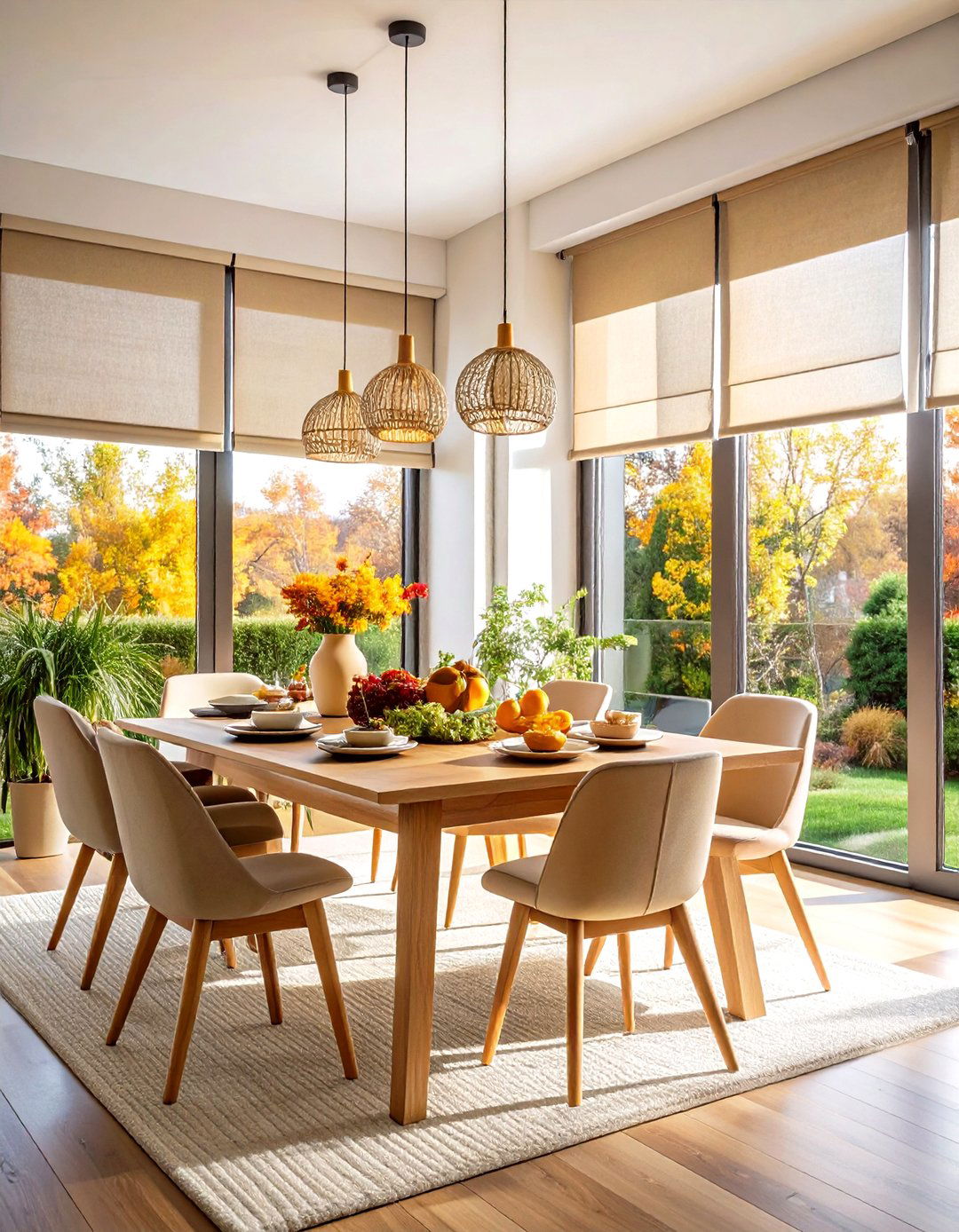
Finally, a curated collection of interchangeable panels lets your dining room window treatment evolve with the calendar, alleviating décor fatigue. Store winter velvet, spring botanical prints, summer gauzy cotton, and autumn plaid in zippered garment bags hung behind the pantry door. Use quick-release track carriers or clip rings to swap fabrics in minutes—no tools, no drama. Label panel hems with tiny nylon tags so returning sets stays organized. Between seasons, launder or dry-clean according to fabric type, then insert cedar sachets to deter moths. Rotating treatments keeps each gathering visually novel and extends the life of every panel by reducing continuous exposure.
Conclusion:
From softly embroidered sheers to tech-forward smart film, the dining room window treatments above prove there is a perfect balance of beauty and function for every table. Each option—whether texture-rich bamboo, energy-saving cellular shades, or stately plantation shutters—manages light, privacy, and acoustics while amplifying your home’s character. Remember to consider ceiling height, exposure, and maintenance habits before committing, and don’t shy away from mixing layers for adaptable ambiance. When the right treatment frames the view and flatters the décor, meals feel warmer, conversations last longer, and gatherings linger happily past dessert. Ultimately, investing thought into window dressing is an investment in everyday hospitality.


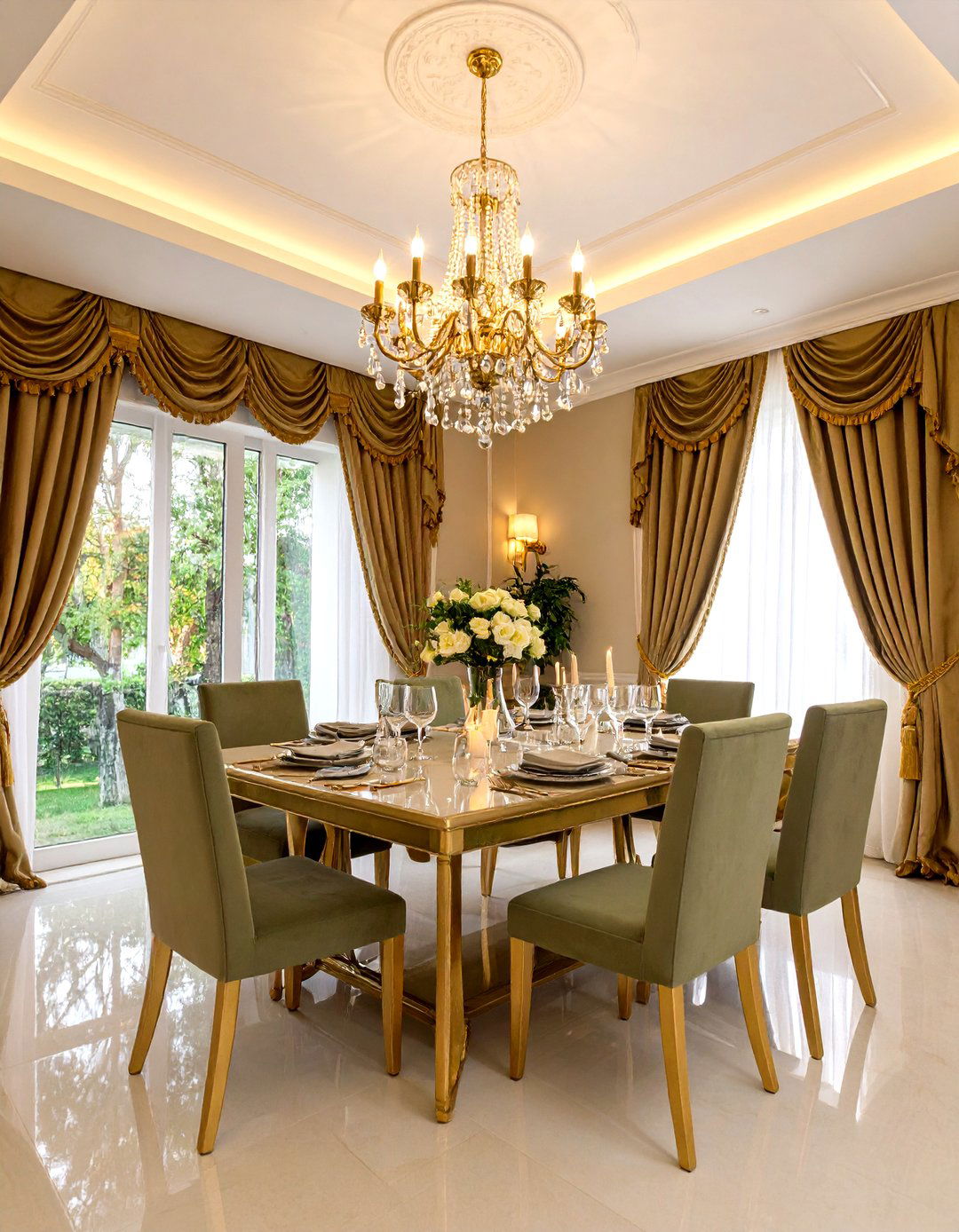
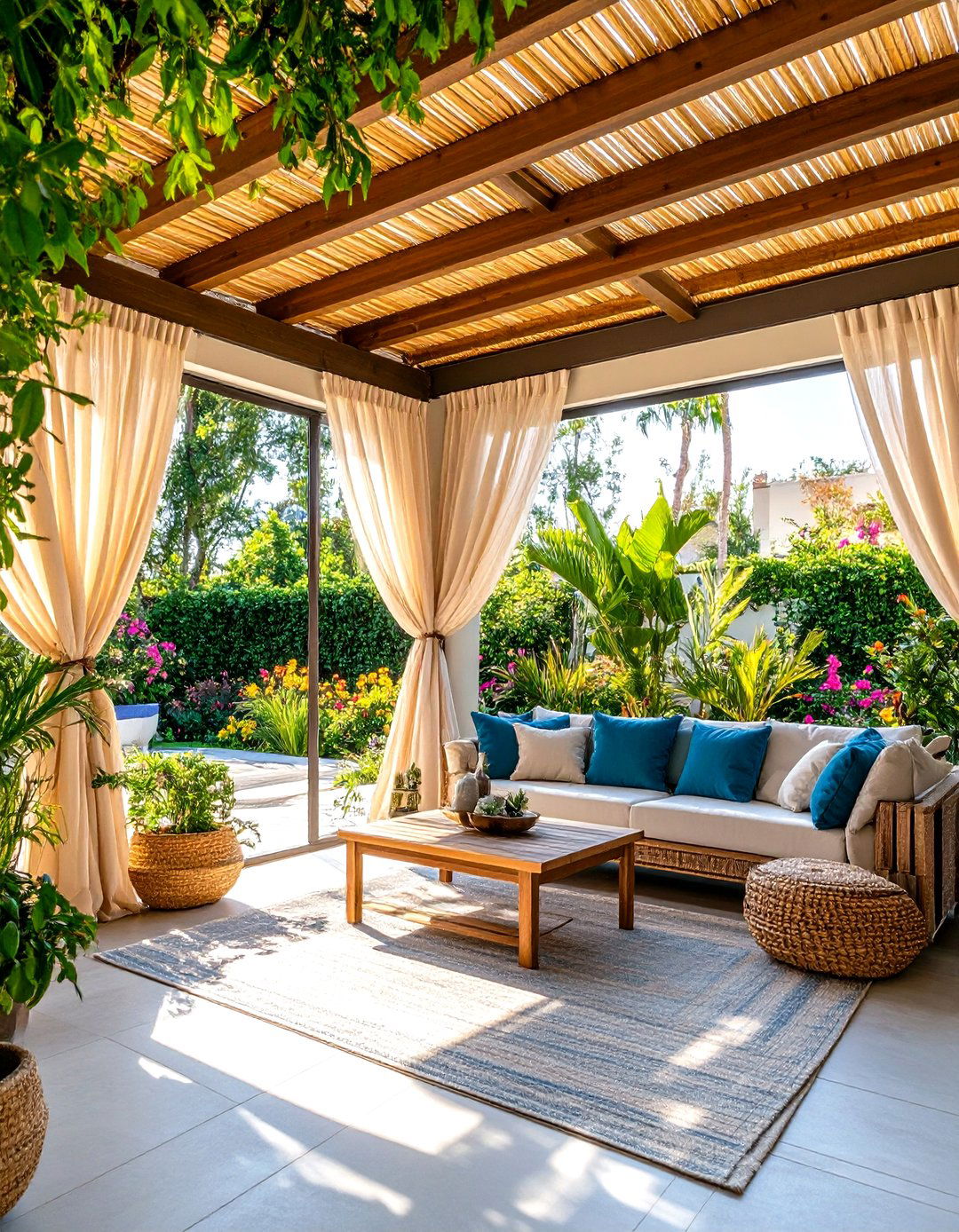







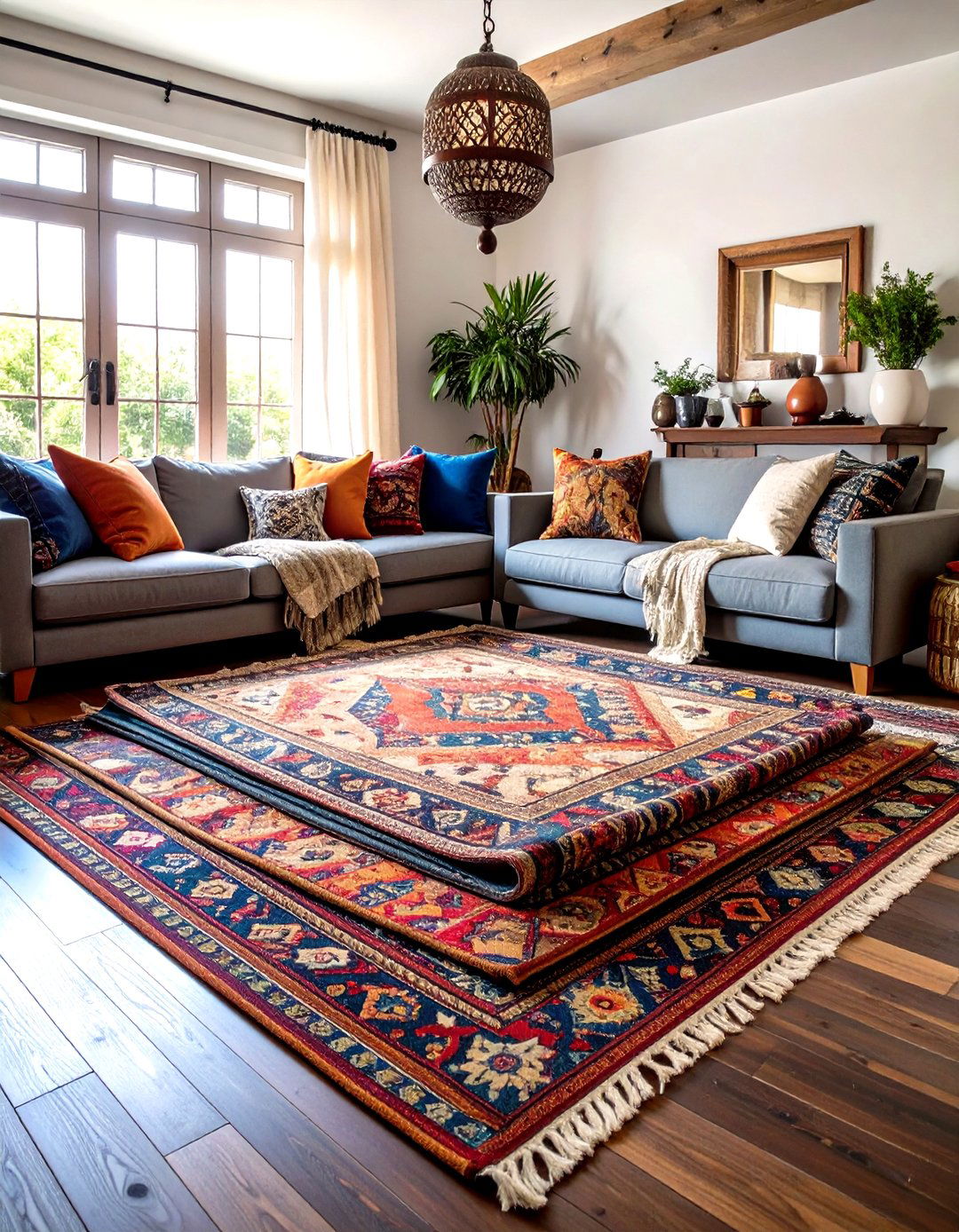
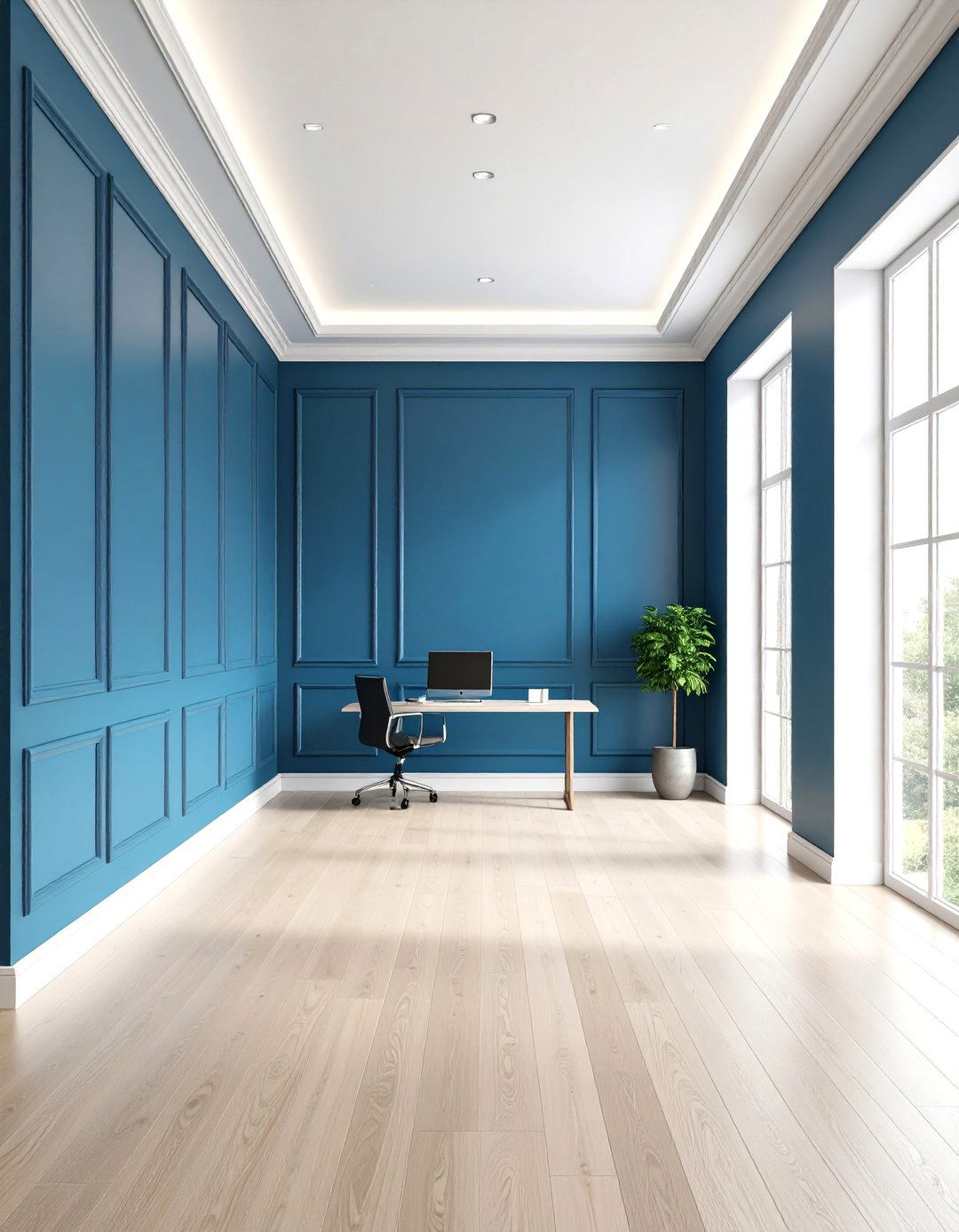


Leave a Reply